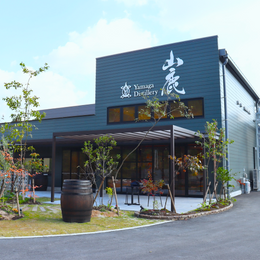Into Kuroki Honten's (黒木本店) Osuzuyama Distillery (尾鈴山蒸留所) & Osuzu Malt (尾鈴モルト) Japanese Whisky: A Legendary Mugi Shochu Maker Takes A Most Artisanal Approach To Bringing Miyazaki's Terroir To Its Japanese Whiskies

Osuzuyama (尾鈴山蒸留所) is the newest distillery belonging to the highly regarded and historic Shochu producer, Kuroki Honten (黒木本店).
Kuroki Honten, based in Takanabe of the Miyazaki Prefecture, produces over 60 Shochu expressions, and has done so since 1885 under the helm of the Kuroki family. They're responsible for some very popular Shochu's such as NakaNaka (中々) and Hyakunen no Kodoku (百年の孤独), and what's especially impressive about them is their commitment to craft distilling. They've employed incredibly artisanal approaches to express Shochu in novel and inventive ways with flavours that were once unthinkable from one of Japan's oldest spirits. What is often seen as a simple and sometimes mundane spirit, has had such preconceived notions overturned by Kuroki Honten's Shochu's.
For Kuroki Honten, it's all about farming, a deep respect for the land, and the desire to express the terroir of their Miyazaki home. Yet despite how greatly respected Kuroki Honten's spirits are, the company and its family - now helmed by the young fifth-generation Shinsaku Kuroki, with his father, Toshiyuki Kuroki, having handed over the reins to the family's business when he took over the role of Mayor of Takanabe - remain incredibly modest and have tended to avoid publicity or even overtly marketing their own brands or products, preferring to let their spirits speak for themselves and to grow organically via their customers' love for it, and instead see their entire operations as predominantly a duty they carry in taking care of their land.


Capturing Miyazaki Prefecture in a bottle.
The artisanship and intense craftsmanship that has won Kuroki Honten such acclaim all begins with their farming. Kuroki Honten is in fact three parts - a farming company, and two distilleries, Kuroki Honten itself and the newer Osuzuyama Distillery, both of which produces Shochu, with the latter better equipped for spirits distilling beyond Shochu. It is at Osuzuyama Distillery that its more recent Japanese single malt making activities are based at. However, as with the recent crop of Shochu producers who have taken to producing whiskies - and to great results - it is instructive to first understand their Shochu-making philosophy, which is what in turn informs the unique ways they produce their whiskies. It is this reservoir of experience making Shochu that has led to their ability to produce such stellar results despite their shorter experience with whisky-making.
And so under the farming company "Reviving The Land", as it is named, the Shochu producer grows a substantial amount of its own ingredients from barley (specifically local Harushizuku and Haruka Two Row barley) to rice and sweet potatoes, which allows them to exert a serious amount of control over the quality and nature of the produce they use. This was spurned by the family's possession of the 43 hectares of land that they had wanted to ensure was farmed sustainably. Anything else they require is sourced from local farmers, making all of their ingredients 100% locally grown. Much of their philosophy surrounded by a strong desire to present Shochu in new ways, but also to best showcase the local Miyazaki terroir. They're also incredibly respectful of the land they reside on, employing organic practices that would be far more common in the best of France's wineries, such as composting and ensuring no chemical fertilizers and pesticides are used - this all feeds into a circularity that they term the zero-waste junkan style system. Any spare capacity Kuroki Honten has is used to grow organic greens and vegetables for the locals.

Osuzuyama Distillery.
In a never-ending pursuit of improving the quality of their Shochu's, Kuroki Honten had thus started a sister distillery in the foothills of Mt. Osuzu, surrounded by lush forestry, which they named Osuzuyama Distillery. The distillery became operational in 1998, and is about a 30 minute drive away from Kuroki Honten's main headquarters (the original distillery started in 1885, and still produces Shochu) that sits by the Pacific Coast in Takanabe. With both distilleries in fairly close proximity within the same Miyazaki Prefecture, it might be intriguing as to why Kuroki Honten had wanted to open another distillery. The answer lies in the desire to be closer upstream to the freshest water spring in the Prefecture, as well as being able to distill and age their spirits in the most pristine and natural environment possible.

The Tsuchima wild cat is a species of leopard cat that is indigenous to Kyushu.
Today, Kuroki Honten's legacy Shochu's like the highly regarded NakaNaka (中々) and Hyakunen no Kodoku (百年の孤独) are produced at the headquarters (the original distillery), whilst newer Shochu's like the Yamaneko (尾鈴山 山ねこ, meaning "Mountain Cat", so named for the local wildcat), Yamazaru (尾鈴山 山猿, "Mountain Monkey") and Yamasemi (尾鈴山 山翡翠, "Mountain Jade", in reference to an endemic kingfisher) are produced at the Osuzuyama Distillery, paying tribute to the local wildlife that it seeks to coexist alongside. As mentioned Osuzuyama Distillery also produces various gins and whiskies in addition to its Shochu's.
The name "Osuzu" itself comes from a local legend of a sacred horse, where a white horse had appeared on a farm at the foot of the mountain. The horse was in fact said to belong to the mountain god, who would ride down on the white horse to visit the local shrine. The horse is said to gallop to the ringing of a golden bell around its neck that would announce the arrival of the mountain god. And thus the mountain was named "Osuzu", which translates as "Bell". This is thus combined with "Yama", meaning "Mountain", in reference to the mountainous terrain the distillery resides upon.

The distillery is nestled amidst the Osuzu mountain ranges.
It was at the Osuzu mountains that the team at Kuroki Honten had found the perfect place to distill their spirits. The forested mountain ranges has an annual rainfall of 3,000 millilitres, and thus has ample clean water flowing through its thirty waterfalls - the water here is incredibly soft, mineral rich, and also naturally filtered and purified as it flows down the mountain range. The distillery is incredibly modest and non-descript, appearing more like a forest lodge than a distillery, and certainly much more unassuming (and even ordinary!) compared to whisky distilleries today. Surrounding the distillery is an assortment of beech, maple and Japanese oak trees, and even local fauna such as kingfishers and wild cats, which have thus become the name of Shochu expressions from Osuzuyama. As highlighted, Osuzuyama has also since 2019 branched out to produce its own gins and single malt Japanese whiskies.
One of the most immediately remarkable aspects of Osuzuyama is how much local wood has been integrated into its distilling equipment. Much of it is Obi-Sugi, a local cedar tree from the Miyazaki Prefecture that was once used to make ships during the Edo period. This Obi-Sugi is used to craft Osuzuyama's koji-making cellars and barrels used to hold its moromi mash, where fermentation occurs in these cedar barrels. And thus with local materials and ingredients, all that's left is for Osuzuyama to incorporate as much human craftsmanship as possible into the making of its spirits - all of the distillery's koji, yeast, and malt is handmade or cultivated inhouse. Distillation then takes place in a very unique manner - the first distillation is always done with a Shochu still, and then for its whiskies, a second distillation is done in a copper whisky pot still, thereby reflecting the Shochu influence in its whiskymaking. We'll delve more into this later.

Inside Osuzuyama Distillery. (Image Source: Umami Mart)
Yet even with two distilleries going, fully dedicated to producing Shochu's, the Kuroki family's desire to continuously seek new challenges and find unique ways to express the Miyazaki terroir would eventually take them into the realms of gins and whiskies in 2019. 4th-generation Toshiyuki-san had personally been a big fan of Scotch whisky, and had thus visited numerous distilleries in Scotland, and in particular grew a great fondness for the Highland distillery Edradour. This planted the seed for him to begin seriously considering if it was possible to fashion a Shochu distiller into something like Edradour. And so by the time his son, 5th-generation Shinsaku-san had returned from his studies in France, it was thus on him to take the family's distillery into new uncharted territories.

Fifth-generation Shinsaku Kuroki.
“My own interest in liquor was originally inspired by wine. Funny, considering I was born into a family of Shochu distillers. That interest led me to study in France, where I realized I was attracted more to the story behind wine—the climate, the culture, and the creator’s philosophy—than to the wine itself. In the end I decided I could, and should, take home the value and allure of what I learned and express it in shochu.” says Shinsaku.
Shinsaku-san had thus wanted to channel the family's deep respect for nature and terroir, and capture all of that in his gins and whiskies. With the combination of organic farming practices, eco-friendly and sustainability initiatives, as well as the access to ultrasoft water from the Osuzu mountains - it was time to take everything the family had put into its Shochu and extend it to Western spirits that were gaining in popularity and would shed light to Kuroki Honten's philosophy in a more international medium.

Kuroki Honten's local barley fields in Miyazaki.
And so using entirely local barley grown on Kuroki Honten's own farm, the harvested barley is then malted in-house in a special proprietary process that Osuzuyama calls "box malting" - the barley is filled into stainless steel vats in a greenhouse, which is then subsequently malted in small boxes in a practice similar to how Koji is made for Shochu. The barley is then dried in the vat using hot airs filled in by dryers which are otherwise used by Kuroki to dehydrate shiitake mushrooms.

The malted barley is then sent from the Kuroki Honten farm up the mountains to Osuzuyama Distillery where it is milled. The barley is specially milled to achieve a higher percentage of husk, which in turns serves as a more rigorous filter bed that allows for a clearer wort to be achieved. Mashing is then done in a Miyake-made stainless steel tuns, with fermentation happening in local Miyazaki Obi-sugi cedar washbacks, also used by Kuroki Honten for its Shochu-making, along with Pinnacle's dry yeast. Distillation finally takes place in a very unique set-up that sees the first distillation taking place in stainless steel Shochu stills, with a second distillation conducted in Miyake-made copper pot stills (a separate copper pot still is used for Shochu and gin production). The Shochu still has a hybrid function that is able to inject steam into the wash, whilst also heating it indirectly using the steam, whilst the copper pot still has a particular configuration of a straight head with a descending lyne arm and a shell and tube condenser.

Shinsaku-san at Osuzuyama Distillery.
With the goal of fully expressing the local Miyazaki Terroir and creating unique expressions, Osuzuyama has thus sought to more prominently use locally sourced yet unconventional casks, such as Cedar wood, Chestnut wood and Sakura - these three have thus formed the first three Japanese single malt expressions to have debuted from Osuzuyama under the Osuzu Malt label (尾鈴モルト).
In both distilleries are dedicated tasting rooms, with the one fitted in Osuzuyama Distillery being a small five-seater bar furnished primarily with local sugi cedar, with two large window panes opening outwards allowing for visitors to enjoy the deep forestry as they taste the spirits of Osuzuyama.
Kanpai!

@111hotpot






